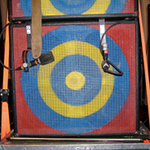Dan Flavin
Dan Flavin: Drawing
Morgan Library and Museum
225 Madison Avenue, New York, NY
February 17–July 1, 2012
Dan Flavin: Drawing, the first museum retrospective of his rarely seen work on paper, includes numerous sketches the artist made en plein air, indicating a predilection to escape the cold fluorescent glow of his indoor electric lightbulb installations and experience fresh air and real sunshine. Several charcoal and pastel drawings of sailboats from the mid-1980s render masts and sails with an economy of means one would expect from a founding Minimalist, their angles evoking The Diagonal of May 25, 1963 (to Constantine Brancusi), 1963, Flavin’s breakthrough sculpture consisting of a yellow bulb mounted on a wall at forty-five degrees—but the chaotic splash of hull hitting water is arrestingly vibrant. Containing works ranging from his moody, expressionistic work of the late 1950s to swiftly scribbled outdoor scenes and portraits drawn from life on loose-leaf notebook pages from a small six-ring binder the artist always carried with him, this illuminating exhibition could have been titled Dan Flavin: Unplugged.
Several sections are dedicated to studies for early three-dimensional work, showing variations of the icons, 1961–64, and the “monument” for V. Tatlin series, 1964–90, and to plans for museums and gallery installations. Some drawings are scrawled notations done by Flavin himself, but others, like the stringent diagram on graph paper from 1984 that documents the arrangement of untitled (in honor of Harold Joachim) 3, 1977, one of two light works in the exhibition, were outsourced to others.
As radical as Flavin’s sculpture is—European Union tax officials recently refused to acknowledge his ordinary fluorescent bulbs and fixtures as art—Dan Flavin: Drawing frames the artist as highly traditional, interested in exploring age-old matters of light and shadow, atmosphere and luminescence, color and line. Selections from his own collection of virtuoso drawings from the Hudson River School and nineteenth-century Japan, hung in a rear gallery, also help to deepen an understanding of Flavin’s avant-garde practice. For an artist who once stated in an interview that he felt it was important to not get his hands dirty, the exhibition touts him as an complex, energetic draftsman who probably washed charcoal and graphite from his fingers every day.
Originally published at Artforum.com on April 2, 2012.
